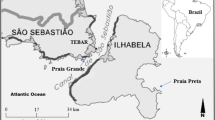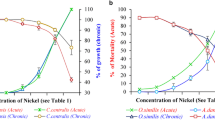Abstract
The objectives of this study were to determine the capacity of the freshwater calanoid copepod Argyrodiaptomus falcifer (Daday, 1905) to accumulate Cr from water, to know the bioconcentration factors in order to evaluate its potential as a biomonitor, and to compare this with data previously obtained with Daphnia magna Straus under identical conditions. By static bioassays using triplicates and a control, a pool of A. falcifer was exposed to three concentrations of Cr (VI): 150 μg/L (T1), 280 μg/L (T2), and 350 μg/L (T3) for 48 h to later determine by Instrumental Neutron Activation Analysis the amount of Cr accumulated. A. falcifer accumulated Cr in all the three concentrations tested. The comparison of T1, T2, and T3 and the control showed significant differences (p < 0.05) but not between the treatments (p > 0.05). On the other hand, A. falcifer accumulated more Cr than D. magna, but these differences were not significant (p > 0.05). Almost no information is available about metal toxicity in freshwater copepods so the reported results are of high importance in order to detect good biomonitors of freshwater Cr-polluted environments.

Similar content being viewed by others
References
Bielmyer, G. K., Grosell, M., & Brix, K. V. (2006). Toxicity of silver, zinc, copper, and nickel to the copepod Acartia tonsa exposed via a phytoplankton diet. Environmental Science & Technology, 40, 2063–2068. doi:10.1021/es051589a.
Bode, P. (1996). Instrumental and organizational aspects of a neutron activation analysis laboratory, PhD Thesis. Delft, The Netherlands: Delft University of Technology.
Chen, C. H., Zhang, P., & Chai, Z. (2001). Distribution of some rare earth elements and their binding species with proteins in human liver studied by instrumental neutron activation analysis combined with biochemical techniques. Analytica Chimica Acta, 439(1), 19–27. doi:10.1016/S0003-2670(01)01024-8.
Chung, Y. S., Jeong, E. S., & Cho, S. Y. (1997). Intercomparison and determination of environmental standard samples by instrumental neutron activation analysis. Journal of Radioanalytical and Nuclear Chemistry, 217(1), 71–76. doi:10.1007/BF02055351.
Das, B. K., & Das, N. (2005). Impacts of quicklime (CaO) on the toxicity of copper (CuSO4, 5H2O) to fish andfish foodorganisms. Chemosphere, 61, 186–191. doi:10.1016/j.chemosphere.2005.02.064.
Eka, H., Nilssona, E., Birgerssonb, G., & Davea, G. (2007). TNT leakage through sediment to water and toxicity to Nitocra spinipes. Ecotoxicology and Environmental Safety, 67, 341–348. doi:10.1016/j.ecoenv.2006.10.011.
Hutchinson, T. H., Williams, T. D., & Eales, G. J. (1994). Toxicity of cadmium, hexavalent chromium and copper to marine fish larvae (Cyprinodon variegatus) and copepods (Tisbe battaglial). Marine Environmental Research, 38, 275–290. doi:10.1016/0141-1136(94)90028-0.
IAEA. (2000). International Atomic Energy Agency, Reference Material IAEA-V10, Trace Elements in Hay Powder, Reference Sheet, January 2000.
Jasan, R. C., Verburg, T. G., Wolterbeek, H. T. H., Plá, R. R., & Pignata, M. L. (2004). On the use of the lichen Ramalina celastri (Spreng.) Krog. & Swinsc. as an indicator of atmospheric pollution in the province of Córdoba, Argentina, considering both lichen physiological parameters and element concentrations. Journal of Radioanalytical and Nuclear Chemistry, 259(1), 93–97. doi:10.1023/B:JRNC.0000015812.46333.41.
Kahle, J., & Zauke, G. P. (2002a). Bioaccumulation of trace metals in the calanoid copepod Metridia gerlachei from the Weddell Sea (Antarctica). The Science of the Total Environment, 295, 1–16. doi:10.1016/S0048-9697(01)01147-0.
Kahle, J., & Zauke, G. P. (2002b). Bioaccumulation of trace metals in the copepod Calanoides acutus from the Weddell Sea (Antarctica): comparison of two-compartment and hyperbolic toxicokinetic models. Aquatic Toxicology (Amsterdam, Netherlands), 59, 115–135. doi:10.1016/S0166-445X(01)00245-4.
Kahle, J., & Zauke, G. P. (2003). Trace metals in Antarctic copepods from the Weddell Sea (Antarctica). Chemosphere, 51, 409–417. doi:10.1016/S0045-6535(02)00855-X.
Koeberl, C. (1993). Instrumental neutron activation analysis of geochemical and cosmochemical samples: A fast and reliable method for small sample analysis. Journal of Radioanalytical and Nuclear Chemistry, 168(1), 47–60. doi:10.1007/BF02040877.
Kovatch, C. E., Thomas Chandler, G., & Coull, B. C. (1999). Utility of a full life-cycle copepod. Bioassay approach for assessment of sediment-associated contaminant mixtures. Marine Pollution Bulletin, 38(8), 692–701. doi:10.1016/S0025-326X(99)00029-6.
Landsberger, S., & Wu, D. (1995). The impact of heavy metals from environmental tobacco smoke on indoor air quality as determined by Compton suppression neutron activation analysis. The Science of the Total Environment, 173, 323–337. doi:10.1016/0048-9697(95)04755-7.
Marchese, M., Gagneten, A. M., Parma, M. J., & Pavé, P. J. (2008). Accumulation and elimination of chromium by freshwater species exposed to spiked sediments. Archives of Environmental Contamination and Toxicology, 55(4), 603–609. doi:10-1007/s00244-008 9139-0.
Miliou, H., Verriopoulos, G., Maroulis, D., Bouloukos, D., & Moraitou-Apostolopoulou, M. (2000). Influence of Life-History Adaptations on the Fidelity of Laboratory Bioassays for the Impact of Heavy Metals (Co2+ and Cr6+) on Tolerance and Population Dynamics of Tisbe holothuriae. Marine Pollution Bulletin, 40(4), 352–359. doi:10.1016/S0025-326X(99)00221-0.
Moraitou-Apostolopoulou, M. (1982). Acute toxicity of copper to a copepod. Marine Pollution Bulletin, 9, 278–280. doi:10.1016/0025-326X(78)90612-4.
Mosulishvili, L. M., Belokobylsky, A. I., Khisanishvili, A. I., Frontasyeva, M. V., Kirkesali, E. I., & Aksenova, N. G. (2004). Application of epithermal Neutron Activation Analysis to Investigate accumulation and adsorption of Mercury by Spirulina platensis biomass. Journal of Radioanalytical and Nuclear Chemistry, 14(35), 1–12.
Paggi, J. C. (2006). Redescription and re-evaluation of the taxonomic status of the neotropical copepod Diaptomus falcifer Daday, 1905 (Calanoida: Diaptomidae). Studies on Neotropical Fauna and Environment, 41(1), 67–78. doi:10.1080/01650520500233687.
Rao, R. R., Holzbecher, J., & Chatt, A. (1995). Epithermal instrumental neutron activation analysis of biological reference materials for iodine. Fresenius’ Journal of Analytical Chemistry, 352(1–2), 53–57. doi:10.1007/BF00322296.
Ravera, O. (2001). Monitoring of the aquatic environment by species accumulator of pollutants: A review. Journal of Limnology, 60(1), 63–78.
Turesson, E. U., Stiernstrom, S., Minten, J., & Adolfsson-Erici, M. (2007). Development and reproduction of the freshwater harpacticoid copepod Attheyella crassa for assessing sediment-associated toxicity. Aquatic Toxicology (Amsterdam, Netherlands), 83(3), 180–189. doi:10.1016/j.aquatox.2007.04.002.
Veado, M. A. R., Heeren, A. O., Severo, M. I., Grenier-Loustalot, M. F., Arantes, I. A., Cabaleiro, H. L., & Almeida, M. R. (2007). INAA and ICP-MSHS: Metal pollutants in fish tissues Nile tilapia (Oreochromic niloticus) in Pampulha Lake, Belo Horizonte city, Minas Gerais State, Brazil). Journal of Radioanalytical and Nuclear Chemistry, 272(3), 511–514. doi:10.1007/s10967-007-0613-3.
Verriopoulos, G., & Moraitou-Apostolopoulou, M. (1982). Differentiation of the sensitivity to copper and cadmium in different life stages of a copepod. Marine Pollution Bulletin, 13(4), 123–125. doi:10.1016/0025-326X(82)90368-X.
Versieck, J., Hoste, J., Barbier, F., & Michels, H. (1978). Determination of chromium and cobalt in human serum by neutron activation analysis. Clinical Chemistry, 24(2), 303.
Wannaz, E. D., Harguinteguy, C. A., Jasan, R., Plá, R. R., & Pignata, M. L. (2008). Identification of atmospheric trace-element sources by passive biomonitoring employing PCA and variogram analysis. International Journal of Environmental Analytical Chemistry, 88(4), 229–243. doi:10.1080/03067310701727411.
Wang, W. X., & Fisher, N. S. (1998). Accumulation of trace elements in a marine copepod. Limnology and Oceanography, 43, 273–283.
Wang, W. X., & Fisher, N. S. (1999). Delineating metal accumulation pathways for marine invertebrates. The Science of the Total Environment, 237–238, 459–472. doi:10.1016/S0048-9697(99)00158-8.
Wood, C. M., McDonald, D. G., Ingersoll, C. G., Mount, D. R., Johannsson, O. E., Landsberger, S., et al. (1990). Effects of water acidity, calcium, and aluminum on whole body ions of brook trout (Salvelinus fontinalis) continuously exposed from fertilization to swim-up: A study by instrumental neutron activation analysis. Canadian Journal of Fisheries and Aquatic Sciences, 47(8), 1593–1603.
Zauke, G. P., & Schmalenbach, I. (2006). Heavy metals in zooplankton and decapod crustaceans from the Barents Sea. The Science of the Total Environment, 359, 283–294. doi:10.1016/j.scitotenv.2005.09.002.
Zauke, G. P., Krause, M., & Weber, A. (1996). Trace metals in mesozooplankton of the North Sea: Concentrations in different taxa and preliminary results on bioaccumulation in copepod collectives (Calanus finmarchicus/C. helgolandicus). International Review of Hydrobiology, 81, 141–160. doi:10.1002/iroh.19960810115.
Zheng, J., Goessler, W., Geiszinger, A., Kosmus, W., Chen, B., Zhuang, G., et al. (1997). Multi-element determination in earthworms with instrumental neutron activation analysis and inductively coupled plasma mass spectrometry: A comparison. Journal of Radioanalytical and Nuclear Chemistry, 223(1–2), 149–155. doi:10.1007/BF02223376.
Acknowledgments
This research was supported by the Universidad Nacional del Litoral (Santa Fe, Argentina). Project CAI+D 2006 N° 21/122. We thank specially Horacio Troiani and María Arribere for helpful work on Cr bioaccumulation in cladocerans.
Author information
Authors and Affiliations
Corresponding author
Rights and permissions
About this article
Cite this article
Gagneten, A.M., Plá, R.R., Regaldo, L. et al. Assessment of Bioconcentration Factor of Chromium by Instrumental Neutron Activation Analysis in Argyrodiaptomus falcifer Daday, a Subtropical Freshwater Copepod. Water Air Soil Pollut 204, 133–138 (2009). https://doi.org/10.1007/s11270-009-0032-x
Received:
Accepted:
Published:
Issue Date:
DOI: https://doi.org/10.1007/s11270-009-0032-x




